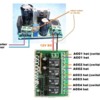I think I understand what you're asking. The above redrawn diagram may help which shows the generalized case. That is, the converter requires some power source (can be AC or DC) as long as it's high enough to support a 12V DC output. Of course it's 18V track AC in your situation.
Because this is a 4-channel relay module, the loads can be separate from the converter power source...albeit they are one and the same 18V track AC in your situation. And since there are 4 independent relays, the 4 channels can switch on/off power to 4 different accessories where each accessory can operate at a different AC or DC voltage...albeit the operating voltages are one and the same 18V track AC in your situation.
So it becomes an exercise in wiring management and what you have or prefer to use in the way of connectors...5-cent twist wire nuts, terminal strips, bus bars, etc. But to your point, yes, there are schools of thought but even though I showed 2-wires going into both converter screw-terminals in my first photo, it's a good idea to have only 1-wire per screw-terminal and to perform any distribution/splitting externally.














